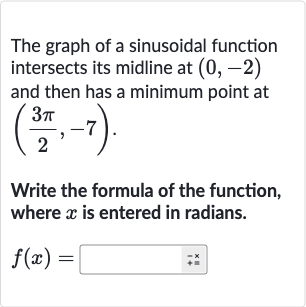Full solution
Q. The graph of a sinusoidal function intersects its midline at and then has a minimum point at .Write the formula of the function, where is entered in radians.
- Determine Midline: Determine the midline of the sinusoidal function. The midline is the horizontal line that the function oscillates around. Since the function intersects the midline at , the midline is .
- Determine Amplitude: Determine the amplitude of the function.The amplitude is the distance from the midline to the maximum or minimum point of the function. Since the minimum point is at , and the midline is at , the amplitude is .
- Determine Period: Determine the period of the function.Since the minimum point occurs at , and this is the first minimum point after the function intersects the midline, we can infer that the period is twice this value. Therefore, the period is .
- Determine Value of B: Determine the value of in the function . The period of a sinusoidal function is given by . Since the period is , we have . Solving for gives .
- Determine Phase Shift: Determine the phase shift, , of the function.Since the function intersects the midline at , there is no horizontal shift, so .
- Write Function Equation: Write the equation of the sinusoidal function.We have determined the following values:Amplitude Midline The function is a cosine function that has been vertically shifted down, so it will be of the form . Substituting the values we found, we get .
More problems from Write equations of cosine functions using properties
QuestionGet tutor help
QuestionGet tutor help
QuestionGet tutor help
QuestionGet tutor help
QuestionGet tutor help
QuestionGet tutor help
QuestionGet tutor help
QuestionGet tutor help
QuestionGet tutor help

